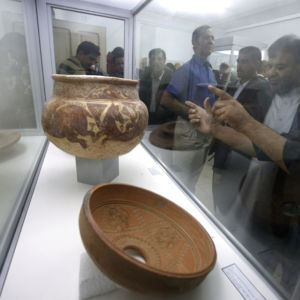Knowingly or unknowingly, super-wealthy art collectors in the United States and Western Europe are propping up terrorist groups like Al-Qaeda and ISIS through the purchase of looted cultural artifacts from war zones. The challenge for law-enforcement, customs officials, and art dealers is the opaque nature of the international art market. The longstanding problem of black and grey-market transactions among dealers and collectors famously led one critic, Robert Hughes, to declare “apart from drugs, art is the biggest unregulated market in the world.”
Officials from the State Department, the Department of Homeland Security, and the Smithsonian testified before the House Financial Services’s Terrorism and Illicit Finance Sub-Committee on Friday morning at a hearing dedicated to “The Exploitation of Cultural Property: Examining Illicit Activity in the Antiquities and Art Trade.”
The smuggling of ancient artifacts is not a new phenomenon. As one congresswoman noted during questioning, one of the most controversial transfers of cultural property happened in the early 19th century when a British aristocrat struck a deal with the Ottoman Empire to bring the Parthenon Marbles from Greece to the British Museum in London. The rightful ownership of those ancient sculptures, which are still housed in the British Museum, remain a bone of contention between the two nations today. During World War II, the Nazi’s systematically looted and sold cultural artifacts and artwork from Jewish collections and public museums, some of which are still being discovered and returned to the descendants of their rightful owners.
While ISIS’s destruction of ancient archeological sites like Palmyra in Syria, or the Great Mosque of al-Nouri in Iraq earlier this week, or the Taliban’s destruction of the Buddhas of Bamiyan in Afghanistan, have garnered significant international attention, less time has been spent in the media on the systematic looting of smaller artifacts which are smuggled and transported across international boundaries and sometimes end up in tony auction houses in London and New York.
Brian Daniels, of the Smithsonian Institution and one of the expert witnesses invited to testify, suggested during the hearing that some of the bigger claims of how much wealth ISIS and Al-Qaeda have pulled in from looting art are overblown. Those estimates, which range up into the billions of dollars, are difficult to corroborate, said Daniels, though he does believe that the issue needs to be addressed seriously. In particular, Daniels argued that the problem is seen too much through the lens of trade, rather than financial crimes such as money laundering.
Both Al-Qaeda and ISIS have organized programs in place where they encourage art thieves and smugglers to strip museums and known archeological sites then tax the proceeds from those activities, said Daniels. While he said that it typically takes years for stolen art pieces to surface, the experts do have a rough sense of the path the stolen goods take before eventually ending up in private and public collections. Daniels testified that to his knowledge, most stolen art goods make their way to Southeast Asia, in countries like Indonesia, Thailand, or Singapore, before being distributed back to major art-trading centers like the U.S., Europe, China, and the Gulf States.
Of particular concern to experts like Daniels is increasing cooperation between organized crime in Western countries and terrorist-linked smugglers. He noted an uptick in looting of archeological sites in Libya, which are then transferred to Europe through powerful organized crime syndicates like the ‘Ndrangheta in Southern Italy. The ‘Ndrangheta, or the Calabrian cousin of the Sicilian mafia, is the primary supplier of hard drugs like cocaine and heroin to most of continental Europe.
The difficulty for art dealers is that without proper documentation explaining an object’s provenance, it is often extremely difficult to tell whether an object is being sold legally or illegally. Further complicating the situation is a culture of secrecy that pervades the art world, which has, by tradition, awarded extraordinary privacy to buyers and sellers trading artworks at auction. Top auction houses, like Sotheby’s in the 1990’s, have been accused of turning a blind eye to illegally stolen artworks and artifacts in order to pocket healthy commission fees.
Law enforcement officials, such as Raymond Villanueva of the Homeland Security Department and another witness on the panel, say they are making strides in cracking down on the illegal markets. Villanueva highlighted a joint operation, Hidden Idols, which recently took down an art-crime ring in New York that was attempting to sell artifacts at Christie’s, the other top-tier international auction house opposite Sotheby’s. Villanueva said that his customs enforcement team trains agents to spot possibly stolen artifacts and gives them the resources necessary to confront possible violations. Nonetheless, Villanueva still acknowledged that the federal government is limited in the investigations it can pursue when many of the problematic transactions occur overseas.
The panel also touched at times on instances of domestic art smuggling—in particular from traditional Native American burial grounds. Like the international crime rings, the experts indicated that they believe that the domestic illegal art trade is also often linked to organized drug trafficking, particularly in methamphetamine.
Unless they receive far more serious cooperation from the art community, the experts did not seem particularly optimistic that the illegal trade will be significantly curtailed in the near future. Daniels, of the Smithsonian, said that imaging and scanning technology is still too rudimentary to create effective databases to recognize stolen artworks, and he seemed bearish on the idea that the United Nations would agree to take serious steps to address the problem.

